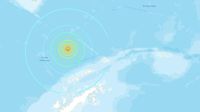Late Thursday night, the South Atlantic Ocean was shaken by a powerful earthquake, rattling nerves across the region and prompting swift action from authorities. According to the United States Geological Survey (USGS), the preliminary magnitude 7.5 earthquake struck at 11:16 p.m. local time in Argentina, its epicenter located about 710 kilometers (441 miles) southeast of Ushuaia, Argentina, deep within the Drake Passage. The quake’s depth was measured at 10.8 kilometers (6.7 miles), a shallow level that’s often associated with more intense shaking at the surface, though in this case, the remoteness of the location meant few, if any, people felt the tremor directly.
Chilean authorities responded quickly, issuing an advisory warning of a potential tsunami along parts of Antarctica. The alert was a stark reminder of the seismic risks that lurk beneath the world’s oceans, even in places rarely in the headlines. The U.S. National Oceanic and Atmospheric Administration (NOAA) later announced that there was no longer a threat of a tsunami, allowing some sighs of relief in scientific outposts and among those monitoring the region. No evacuation orders were declared for Chile or Argentina, the two nations geographically closest to the quake’s epicenter. As of Friday, there were no immediate reports of damage or casualties, a fortunate outcome given the earthquake’s strength.
The Drake Passage, the site of this seismic event, is a narrow stretch of water connecting the South Atlantic and South Pacific oceans, sandwiched between the southern tip of South America and the Antarctic Peninsula. While not as notorious for earthquakes as Chile’s long Pacific coastline, the Drake Passage is no stranger to geological activity. According to the Associated Press, it “straddles a highly active seismic and geological zone,” making it a place scientists keep a close eye on, even if it doesn’t often make the news.
What makes the Drake Passage particularly fascinating is its role as a gateway between two vast oceans and its proximity to the Antarctic. The region is remote, sparsely traversed except by scientific expeditions, adventurous sailors, and the occasional cruise ship. Its isolation likely helped limit the immediate impact of this earthquake—there are no large cities or coastal communities within hundreds of kilometers. Still, the event served as a wake-up call about the seismic hazards that exist even in Earth’s farthest reaches.
The USGS initially reported the earthquake’s magnitude as 8.0, but later revised it to 7.5. This kind of revision isn’t unusual in the minutes and hours after a major quake, as scientists analyze data from seismic networks around the world. The difference, while significant on paper, doesn’t change the fact that this was a powerful event by any measure. The earthquake’s shallow depth also raised concerns about the potential for tsunami generation, which is why Chilean authorities were quick to issue their advisory, even though the risk was ultimately deemed to have passed.
“A major, preliminary magnitude 7.5 earthquake struck in the South Atlantic Ocean on Thursday (August 22, 2025),” the United States Geological Survey reported, prompting Chilean authorities to issue an advisory for a potential tsunami along parts of Antarctica. There were no evacuation orders immediately declared for Chile or Argentina, the two countries closest to the quake zone. The temblor happened at 11:16 p.m. local time in Argentina about 710 km southeast of Ushuaia, Argentina, in the Drake Passage, according to the U.S. Geological Survey. The earthquake had a preliminary depth of 10.8 km.”
While the South Atlantic is less prone to the “megathrust” earthquakes and devastating tsunamis that periodically strike the Pacific and Indian Oceans, it is not immune to seismic hazards. History provides sobering examples. The 1929 Newfoundland earthquake, for instance, triggered a deadly tsunami that killed more than 20 people on Canada’s Burin Peninsula. The infamous 1755 Lisbon earthquake—one of the deadliest in European history—produced a massive tsunami that swept across the Iberian Peninsula, North Africa, the Azores, and even reached the Caribbean and Newfoundland.
Most tsunamis are generated by subduction zone earthquakes, where one tectonic plate dives beneath another, displacing huge volumes of water. While the Atlantic Ocean doesn’t have the same concentration of subduction zones as the Pacific, it does have other geological features capable of producing tsunamis. Underwater landslides, for example, are considered a major risk in the Atlantic basin. The continental slopes off the eastern coasts of the U.S. and Canada, the Puerto Rican Trench, and the Storegga Slides off Norway’s coast are all areas where such events could occur. In rare cases, these submarine landslides can generate large waves that travel thousands of kilometers, threatening distant coastlines.
Another potential tsunami risk in the Atlantic is volcanic activity, particularly in the Canary Islands. Scientists have speculated that a catastrophic collapse of the La Palma volcano’s western flank could, in theory, trigger a tsunami with waves up to three meters high reaching the U.S. East Coast. While this scenario is considered unlikely, its potential impact underscores the importance of monitoring seismic and volcanic hazards throughout the Atlantic region.
The recent earthquake in the Drake Passage, while not resulting in widespread destruction or loss of life, highlights the unpredictability of natural disasters and the need for vigilance. The event also serves as a reminder that even remote, sparsely populated regions can generate hazards with far-reaching consequences. According to NOAA, “there was no longer a threat of a tsunami after an earlier advisory by Chilean authorities for parts of Antarctica.” Still, the quick response from authorities and the international scientific community demonstrates the value of robust monitoring and preparedness systems.
For now, the Drake Passage remains quiet, its icy waters undisturbed by further seismic activity. But the earthquake of August 22, 2025, will be remembered as a moment when the world’s attention briefly turned to one of its most remote and mysterious corners—a place where the forces of nature, though often hidden, are always at work beneath the waves.
As researchers continue to study the seismic dynamics of the Drake Passage and the broader South Atlantic, the lessons from this event will inform future efforts to predict, prepare for, and respond to the hazards that lie beneath the ocean floor. The region’s remoteness may shield it from the worst human impacts, but as history shows, the effects of earthquakes and tsunamis can ripple far and wide, crossing oceans and continents in their wake.







